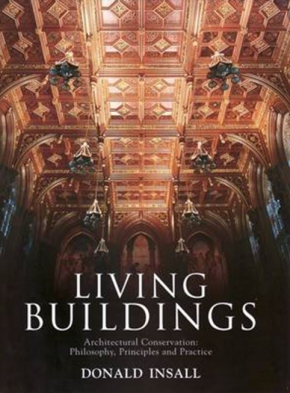Living Buildings. Architectural Conservation: philosophy, principles and practice
Living Buildings. Architectural Conservation: philosophy, principles and practice, Donald Insall, Images Publishing, first published 2008, reprint 2018, 272 pages, 66 black & white and 565 colour illustrations.
Sir Donald Insall is an internationally renowned pioneer of architectural conservation. The updating and reprinting of Living Buildings in 2018 was a celebration of his 60 years of conservation practice, a few years earlier than the anniversary of the Venice Charter. The reader is conducted through the book by Insall’s voice telling captivating stories about befriending old buildings.
After a summary of his professional journey, Insall devotes 20 pages to explaining that buildings are alive, highlighting examples of phases and changes that a building goes through during its lifespan. Then he outlines the methodology of organising the conservation project. The philosophy and principles of conservation are fleshed out by illustrated examples of actual projects. This is a great guide for students and practitioners of architectural conservation. It includes practical tips, such as the rationale for organising the report. ‘For order and consistency, we like to work from the general to the particular, and from fact to opinion. In this way, detail falls within its broader framework, both in historical sequence and in terms of spatial layout.’
The philosophy and principles of conservation are further explained by defining, by means of case studies, 10 degrees of intervention that buildings may be subjected to, emphasising that every building is unique. The first and least intrusive degree is the ‘day-to-day building care’ at the bottom of the ladder, while at the top are ‘new buildings in context’ and ‘conservation in changing historic areas’, with different degrees of intervention in between. An example of the day-to-day building care is the programme of systematic and continuous major repairs, which was developed for Trinity College, Cambridge. Accordingly, work continued in the different buildings and parts of the college without a break since the early 1970s.
An example of ‘conservation in a changing historic area’ is the pilot scheme that was developed for the Bridgegate area in the historic city of Chester, including renewal, replacement and integrating new buildings with old ones. Different degrees of intervention are illustrated by interesting examples, varying in scale and nature of buildings, areas and cities as well as different conservation issues. This part is concluded by a chapter making the point that many degrees of interventions may be applied within the same building according to different situations, values and issues. The rationale is illustrated by the post-fire restoration at Windsor Castle.
‘Living Buildings’ is philosophy of conservation without long-winded arguments. It advocates principles of conservation, distilling 50 years of conservation practice. The book is generously illustrated by crisp photographs, explanatory drawings and sketches, with some fabulous hand-drawn axonometrics. The text is full of wise words of advice on approaches, methods and techniques for understanding historic buildings, and finding out their defects and addressing them, while keeping in mind the needs of their owners.
This article originally appeared as ‘Friend of old buildings’ in IHBC's Context 164 (Page 52), published by The Institute of Historic Building Conservation in March 2020. It was written by Hossam Mahdy, international freelance consultant on the conservation of built heritage.
--Institute of Historic Building Conservation
Related articles on Designing Buildings Wiki
IHBC NewsBlog
Old Sarum fire in listed (& disputed) WW1 Hangar - Wiltshire Council has sought legal advice after fire engulfed a listed First World War hangar that was embroiled in a lengthy planning dispute.
UK Antarctic Heritage Trust launches ‘Virtual Visit’ website area
The Trust calls on people to 'Immerse yourself in our heritage – Making Antarctica Accessible'
Southend Council pledge to force Kursaal owners to maintain building
The Council has pledged to use ‘every tool in the toolbox’ if urgent repairs are not carried out.
HE’s Research Magazine publishes a major study of the heritage of England’s suburbs
The article traces the long evolution of an internal programme to research 200 years of suburban growth
IHBC Context 183 Wellbeing and Heritage published
The issue explores issues at the intersection of heritage and wellbeing.
SAVE celebrates 50 years of campaigning 1975-2025
SAVE Britain’s Heritage has announced events across the country to celebrate bringing new life to remarkable buildings.
IHBC Annual School 2025 - Shrewsbury 12-14 June
Themed Heritage in Context – Value: Plan: Change, join in-person or online.
200th Anniversary Celebration of the Modern Railway Planned
The Stockton & Darlington Railway opened on September 27, 1825.
Competence Framework Launched for Sustainability in the Built Environment
The Construction Industry Council (CIC) and the Edge have jointly published the framework.
Historic England Launches Wellbeing Strategy for Heritage
Whether through visiting, volunteering, learning or creative practice, engaging with heritage can strengthen confidence, resilience, hope and social connections.















